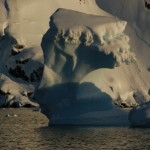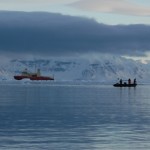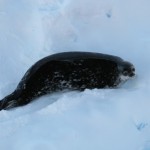Zooplankton. Pronounced Zo [like AlonZO Mourning ex-Georgetown and Miami Heat center) – plank [like what pirates would make you walk on] – ton.
- Cool Ice
Don’t make the rookie mistake I did on my first cruise and say it like Zoo [the place you go with all the animals] – plankton. These are the small animals that live in the ocean and here in Antarctica, there are many many many different types of these animals ranging from microscopic ones to chains of gelatinous animals that can be 10 or 20 meters in length (i.e. as big as a whale).
The most important zooplankton here in Antarctica are krill. These animals are crustaceans (if you saw them you’d say they looked like shrimp, but they’re not shrimp), are around 4 or 5 cm in length as adults, and they serve as the primary food source for all of the larger animals in the Southern Ocean ecosystem.
- Tag Boat
It is tough being one of the few people on this ship who find little animals far far far more interesting than the charismatic megafauna (i.e. whales, pinnipeds, heck, even seabirds) that everybody else on this boat is studying. But you can’t understand the ecology of either the zooplankton or the whales without knowing information about the other. Thus, despite our differences we can work together to try and better understand how these very different types of animals can affect the other.
If you wanted to catch, count, or measure the zooplankton in the ocean, you might use a net. We’re actually doing our first net tows of the cruise right now as I type this so hopefully in a few days we’ll post some pictures of some of the zooplankton that we find here. However, net tows only measure the animals at one spot in the ocean, and we know that both the zooplankton and the animals that eat them (like whales) are moving around in the ocean; another tool that oceanographers can use to study zooplankton is acoustics.
Essentially (and kind of simplified), we have instruments that work very much like the depth-sounder or fish-finder you might see on any boat. They transmit a very short pulse of sound (at pretty high frequencies (38 or 120 kHz in our case)) that travel downward through the water column. The instruments then listen for echoes from any type of scattering that might occur in the ocean. A very strong return occurs off the ocean bottom, and by measuring how long from when we sent the sound to when we heard the bottom echo, we can measure how deep the ocean floor is beneath us. If there are enough animals (like fish or zooplankton) in the water, they will also scatter enough sound for us to detect. From these measurements, we can get very high resolution (less than 1 m in the vertical, ~ 10 m in the horizontal) pictures of where the scatterers are in the ocean and how many of them there are. Here in the Southern Ocean, the dominant scatterer is krill so our data produces “maps” of where krill are in the water column and how many of them there are. This information is really useful in trying to understand the behavior of krill predators (like humpback whales).
- Weddel Seal
For example, if you wanted to know where college students are on a friday night, you might want to see if any establishment was offering free pizza – because the location of college students is often highly correlated with free pizza. Thus if you saw a lot of college students walking towards a particular restaurant and you knew that that restaurant had free pizza and all the other restaurants had expensive pizza, you’d have some insight into understanding college student behavior. OK, that last analogy may not make any sense. It’s late on a friday night and I was out on a small boat for about 7 hours so my brain may still be thawing out. Hopefully the next post will be more coherent. Here are some pictures that I took today that somebody else picked out as I’m too tired to think straight anymore.




Congrats to the Blue Devils Getting Their M.S. Degree Today!
Special kudos to Linds and anyone else who is becoming an M.S. Blue Devil today! Sorry you are missing the pomp and circumstance, but you are having many more reasons to celebrate during the weeks to come. Congrats on this great accomplishment and good luck to all in your future endeavors. Much love, mom
P.S. Love the mask, Linds
Cruestacean and Enviroment
Thank you for posting infomation about krill, I am in a aquascience class at Fairhope High School and we are currently studing about crustaceans and I think the play a big role in our enviroment, are school is on the coast of alabama and we are currently dealing with the oil spill so I hope the infromation yall found out will help with the marine life in the gulf.
WOW
It amazes me how hard you all are working! AND how one little animal can have such a huge effect!
That’s Very Interesting!
I think that what you guys are doing is great ! Nobody really takes into consideration about the little things that could impact us if they weren’t here . But keep up the good work !